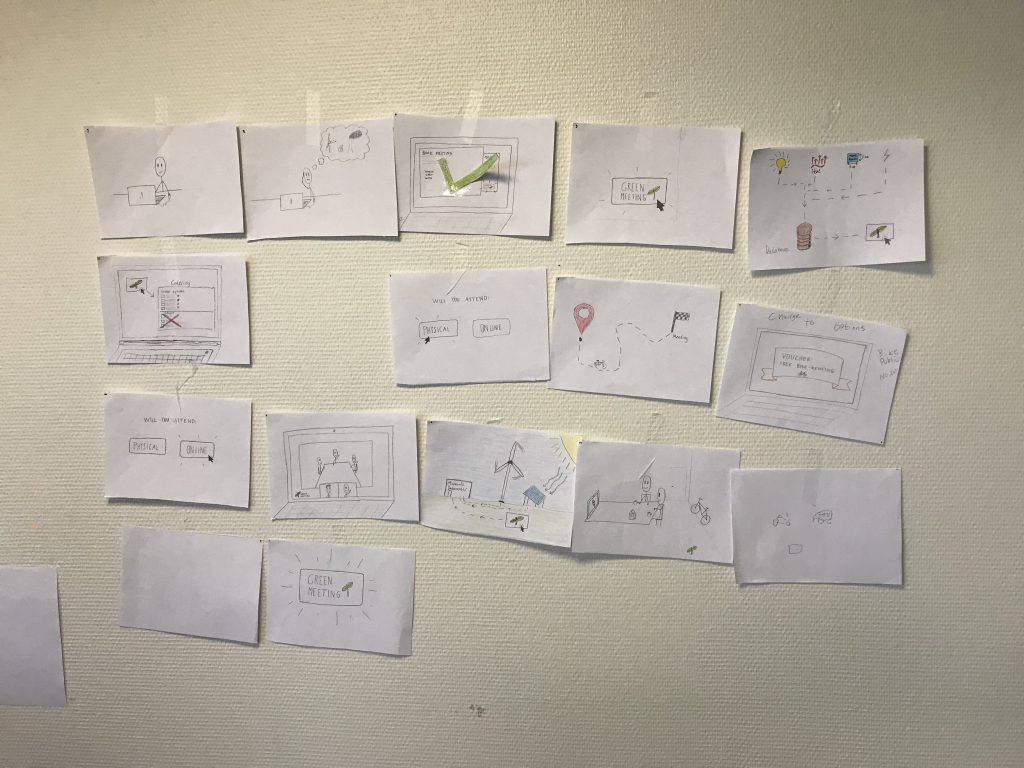Members of the team:
Frederik Johann Dennig Becker, fbecke18@student.aau.dk
Esther Mogensen, emoge21@student.aau.dk
Gesine Alexandra Rebmann, grebma20@student.aau.dk
Nicolai Hald Jepsen, njepse18@student.aau.dk
Simon Sand Larsen, ssla21@student@aau.dk
Short case description
AskCody is a cloud-based SaaS company with head office in Aalborg and sales office in Boston, USA. AskCody provides one of the global leading meeting management platforms – including meeting room booking, meeting services, catering, visitor management and workplace insights. The AskCody platform is an integration in Microsoft Outlook who are their main partner.
(AskCody wishes to support the hybrid work model which has flourished due to Covid-19 the last year. Besides a solution that supports the trend of hybrid work, AskCody also wants to encourage their costumers to lower CO2 footprint.)
During this case our group came up with a data-based feature in the AskCody software that both allows the costumer companies to get more intelligent data from their buildings/meeting rooms and also makes it easier to take sustainable decisions within these companies.
Final concept video with thoughts behind the idea
Our final concept is called ‘Green Meeting’ which is a new feature in the AskCody software. In the video you see an employee, Bob, and his meeting booking process with the Green Meeting function.
With this feature we want to make is easier for a normal employee within a company to book sustainable meetings and make more sustainable choices without using precious time. The Green Meeting feature will instead make all the sustainable choices for Bob, so he doesn’t have to think about anything.
The video will show the different aspects of sustainability that the Green Meeting is trying to accommodate and how these sustainable choices also affects Bobs’ company in a greener, positive way.
Data collection
Based on the case description we decided to conduct interviews and set up interview guides for the field work at AskCody on Wednesday, the 3rd of November. The questions for those interviews were framed as to understand their problem area better and possible uncover the areas in which solutions could be possible. We were hoping to encounter different context in which to pose the questions.
In advance of the field study, we also asked for meeting specific data backlog as quantitative data, which would provide us with insights into the last 3-6 months. We were asking to receive data regarding, which rooms (room capacity versus how many people attended, room number/name), how many people attended physically, digitally at the different meetings, if there were catering (what kind of food was available) or if there weren’t, and if there were, how much of it was wasted, if rooms were heated during the meeting or before, etc. Unfortunately, AskCody wasn’t able to provide all of the data, especially not the one on services, which though helped us to easier identify where the solution could be headed. The data they were able to prepare was very helpful and we were able to analze it so it would benefit out progress.
Once the fieldstudy was happening, we could directly see how AskCody was working on a day-to-day basis in their office. We were able to take many pictures and work with the interface. Hence, we collected valuable understanding of the hickups with the solution and the benefit it offers to customers. Compared to the anticipated interviews, we were only able to talk with personnel for a short period of time with the whole group of 15 people being present, which left little room for flexibility and conversation. After all, we were very happy with the data that we got and used it as a great basis to our further process, especially when it came to the problem formulation with affinity diagrams and innovation tracks.
Affinity Diagram
Based on our findings from the field research we gathered the key findings in an Affinity Diagram. Here the findings were clustered in themes, and we identified problems and possibilities for each theme. Based on their problems/possibilities we chose which themes we wanted to work with; sustainability, making ‘Insights’ better. (Please click on the image to open in a new tab to view it full size)
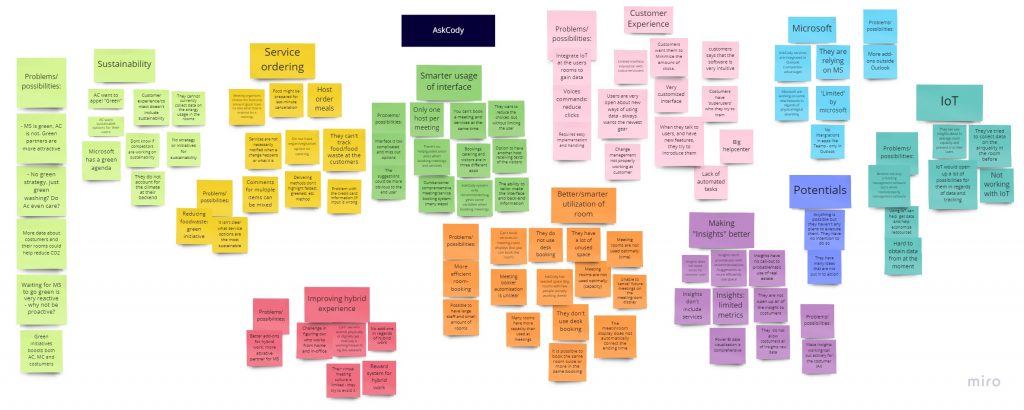
Core Design
We chose the key findings that we found most important and redefined them to quality criteria for core designing. We made five criteria which we placed differently in five different innovation tracks based on the Core design Circle. (Please click on the image to open in a new tab to view it full size)
Summary of second case partner meeting
After creating the five different innovating tracks, we had the chance to talk and evaluate with our case partner. This was done with the purpose choosing or creating one innovation track to focus on for the rest of UCRAC. The representatives from AskCody that was present at liked innovation track 2 (turquoise) and track 4 (blue).
Track2:
Track two focuses on hybrid work as a primary focus and should motivate companies to implement hybrid work into the organizational culture as a second priority. If the company culture at the customer is influenced towards hybrid, it can become easier to implement it into daily tasks or meeting in the company. While the tertiary priortiy was set to be easy and intuitive to use, this was challenged by AskCody, as they can make solutions more intuitive with their own resources. Lastly, the active use of data, should make data more usable and analysable to the customer. From AskCody’s point of view, this point should have higher priority which is why they also highlighted it based on track 4.
Track4:
Track four is grounded in active usage of data as primary focus. This indicates the that insights for the customers are acting based on the insights of the AskCody interface and get informed for data driven decisions. While here the second choice was also the system is intuitive to use, which was discarded by AskCody, the thought to replace this with the hybrid meetings as a secondary priority was well taken.
The tertiary priority, motivate customers to use the AskCody solution, describes that it should be easy to understand for them what the added value of the solution is. The quandary priority is to optimise customers’ usage of resources, as AskCody should optimise the customers’ usage of both the building space, foodwaste, heating or other.
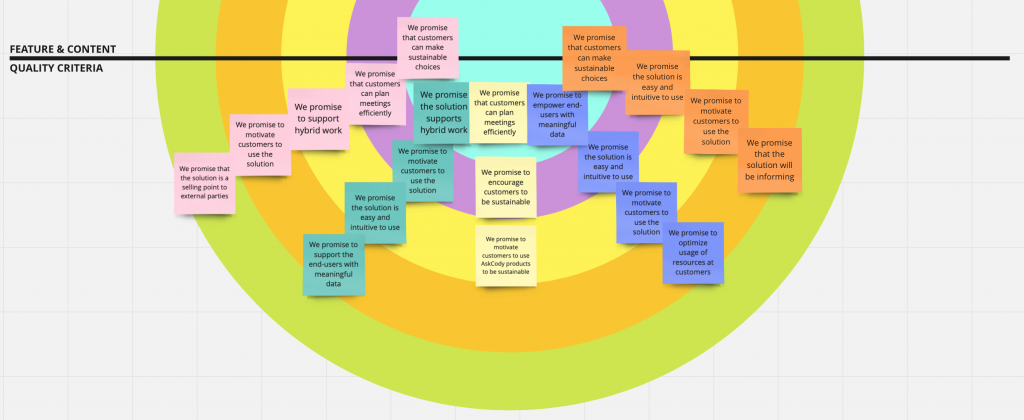
The HMW question and ideation
The process of ‘How Might We’ and ‘Ideation’
As the first part of the second week, this was used at the way towards the solution-based part of U-CrAc. We have worked with the method of ‘How Might We’ (herein after referred to as HMW)-questions to have a structured brainstorm session, which enabled us to generate ideations for solving the case description. The use of the HMW method helped us explore the varies of different ideations possible to each concept. This process is primarily based on the research we made at the AskCody in the first week at our field work, which is stated in the affinity diagram and the emerged core design. By using this method, we could narrow the ideas down to a more specific solution-based process for the coming week.
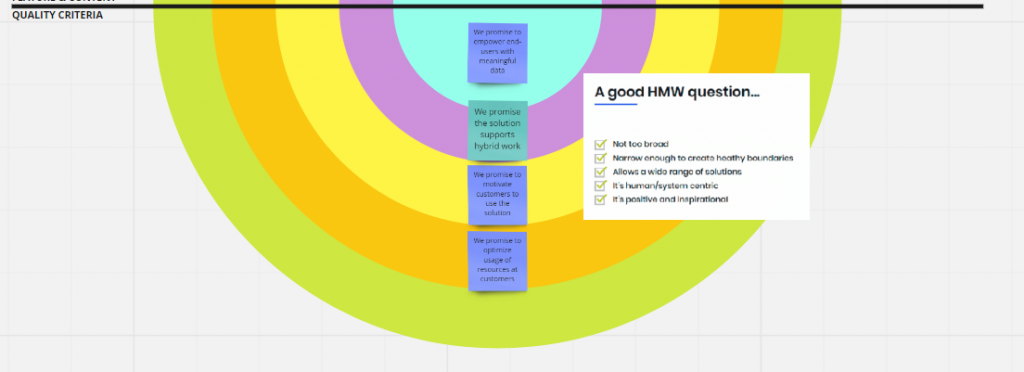
Finally being able to move into solution space, this was used at the way towards the solution-based part of U-CrAc. We all were delivering 3 questions to have a structured brainstorm session, which enabled us to generate ideations for solving the case description. The use of the HMW method helped us explore the varies of different ideations possible to each concept. This process is primarily based on the research we made at the AskCody in the first week at our field work, which is stated in the affinity diagram and the emerged core design. By using this method, we could narrow the ideas down to a more specific solution-based process for the coming week.
Discussing those withing the group, we finalized one central HMW question that should guide the rest of our process.
Narrowed down to three HMW questions
- How might we make AskCody the intelligent personal assistant for each end-user?
- How might we motivate employees to stay home so companies can reduce their employees’ carbon footprint and better utilize their own resources?
- How might we motivate customer to thrive and become more hybrid and sustainable with meaningful data?
The final HMW question
How might we make AskCody the intelligent assistant to motivate end-users to thrive in a hybrid and/or sustainable work environment?
The final three ideations
- A digital avatar that uses the data from meeting booking and services, as well as IoT to synthesise tangible resolutions that can optimise a company’s resource utilisation
- Options are automatically chosen as to support hybrid and sustainable – e.g. meeting link for teams automatically set, room with amount of people
- The organisation will get a score, either monthly or yearly, of how much GHG they have saved. The employee will be rewarded in somewhat way based on the organisations overall score?
Working with the HMW questions as a foundation, we went into concept creation. First of all, the HMW question was the starting point for 8 concepts of which the best 5 (as chosen by the group, marked in green).
The Concepts brainstorm
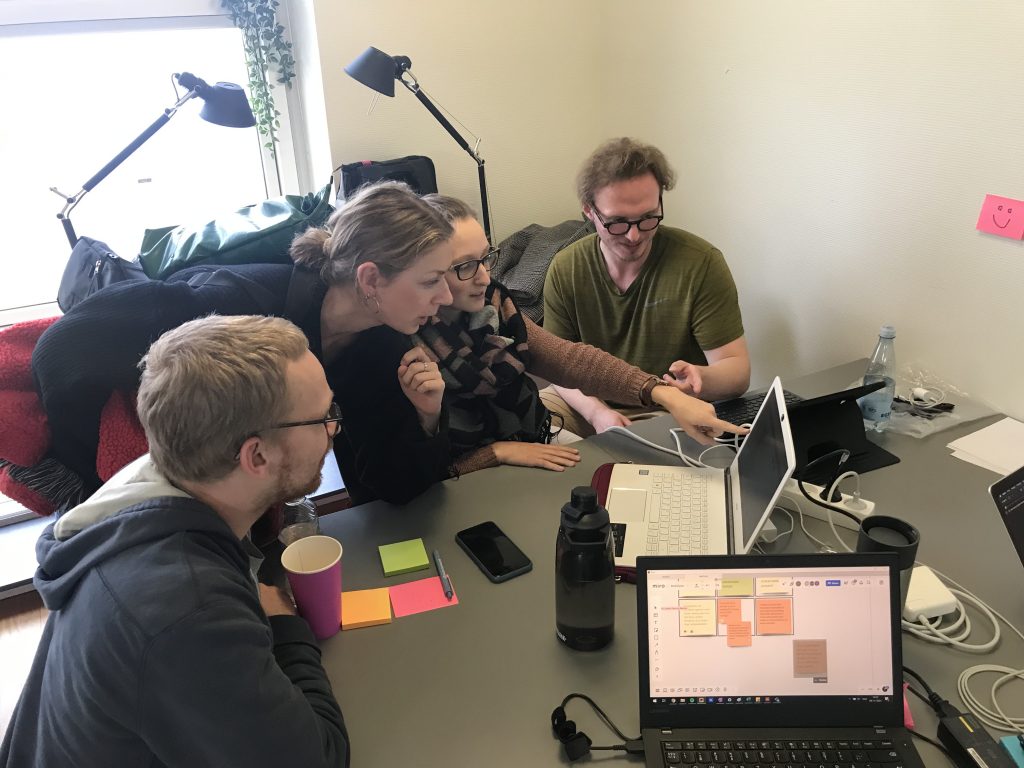
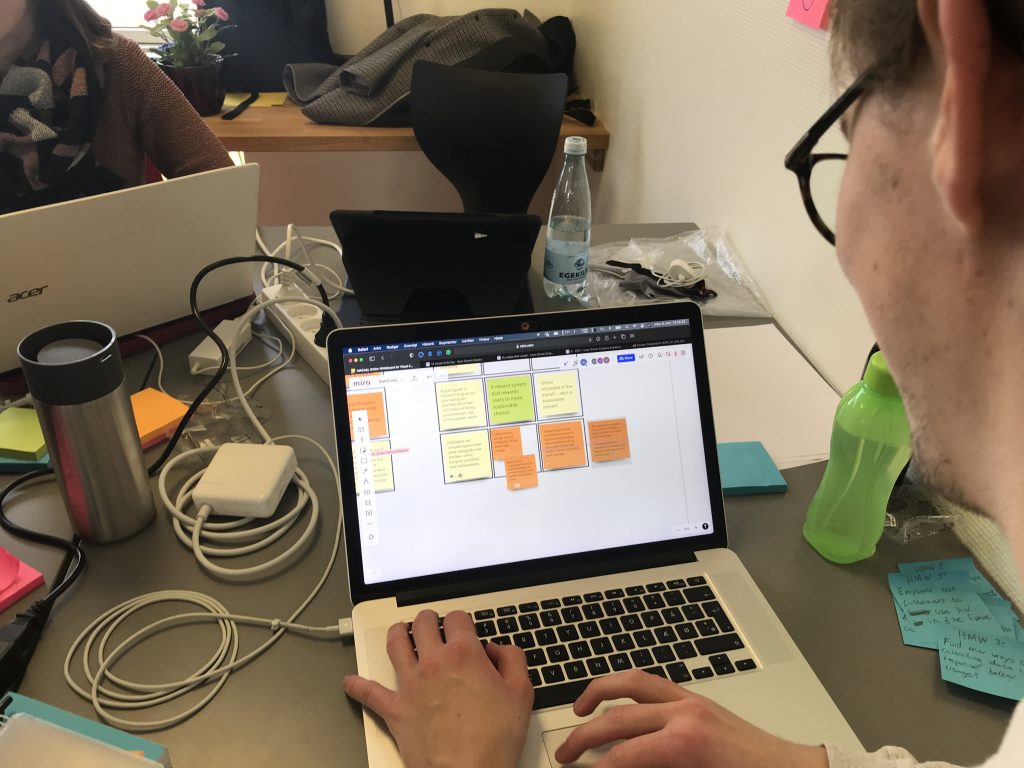
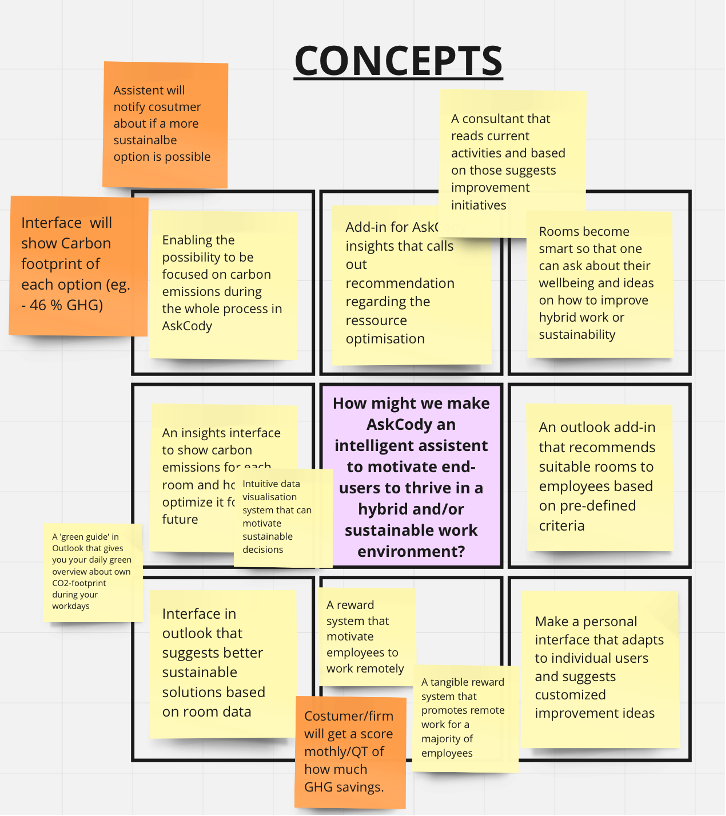
The final five concepts (the green post-it’s)
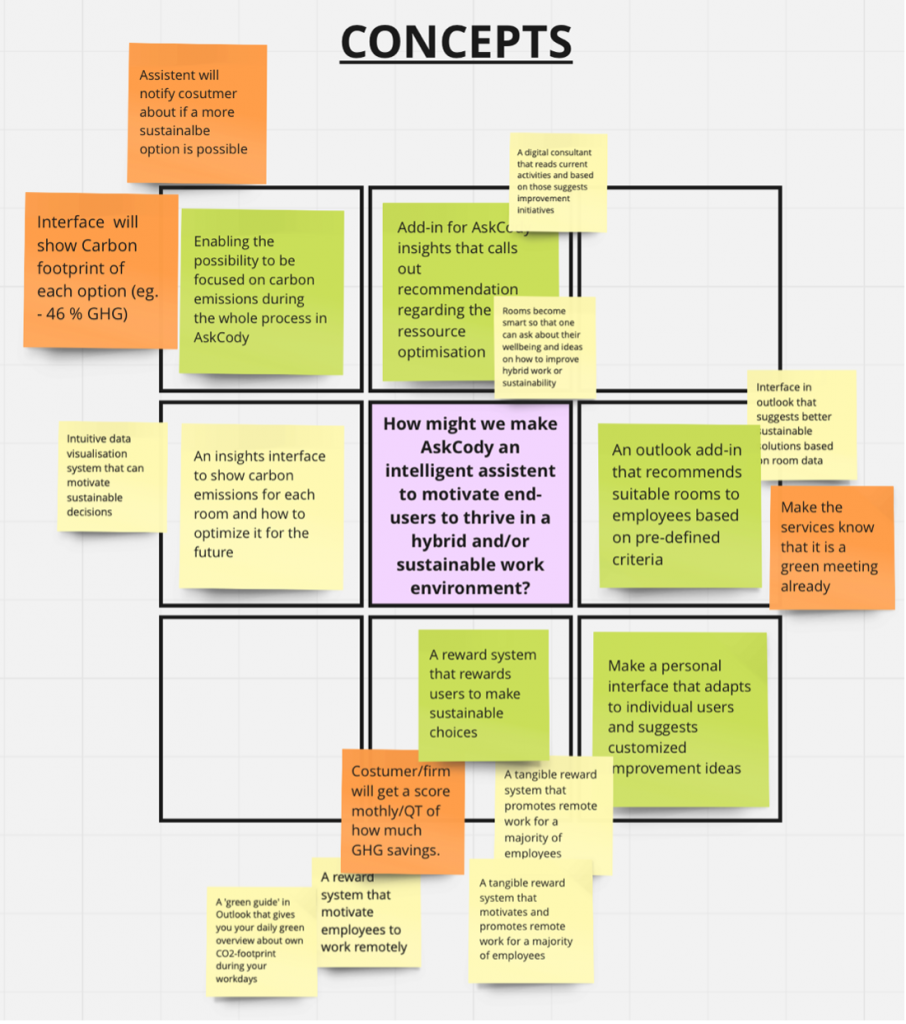
Those were then further iterated into up to 8 solution-options each.
The ideation for the selected five concepts
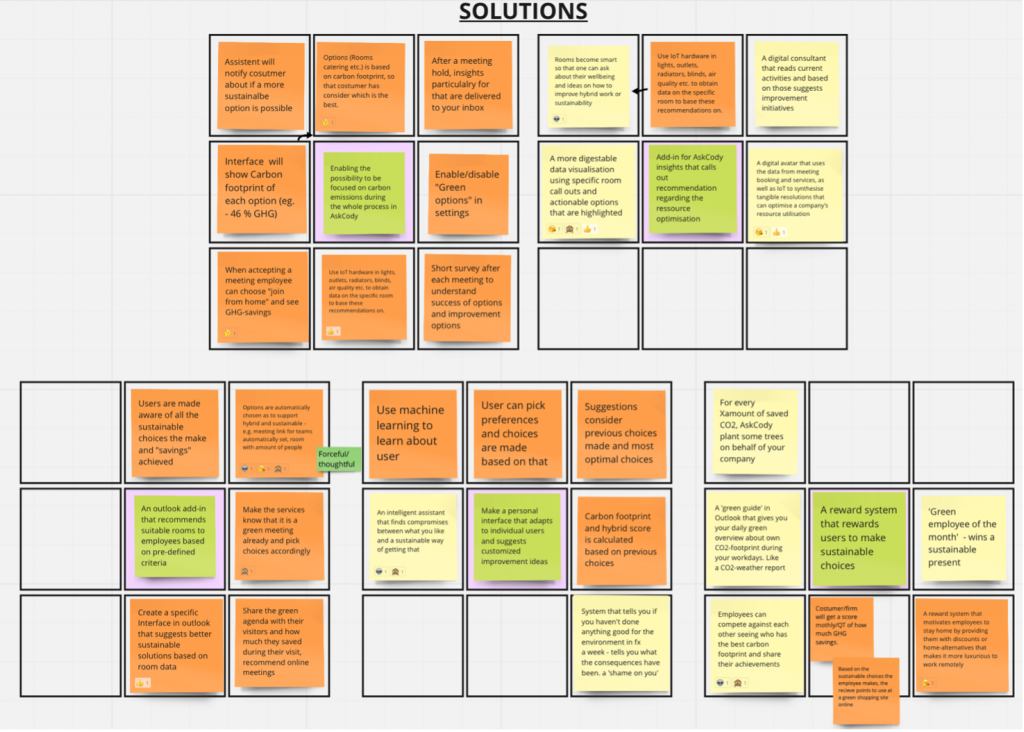
(Please click on the image to open in a new tab to view it full size)
The three final ideations
Out of the 30 created solutions, we chose the 3 best ones to work with after that. They formed the basis of the three video sketches to bring across the idea.
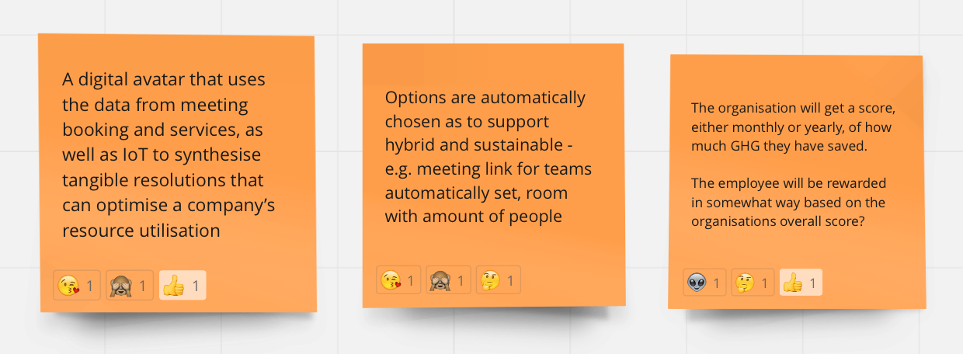
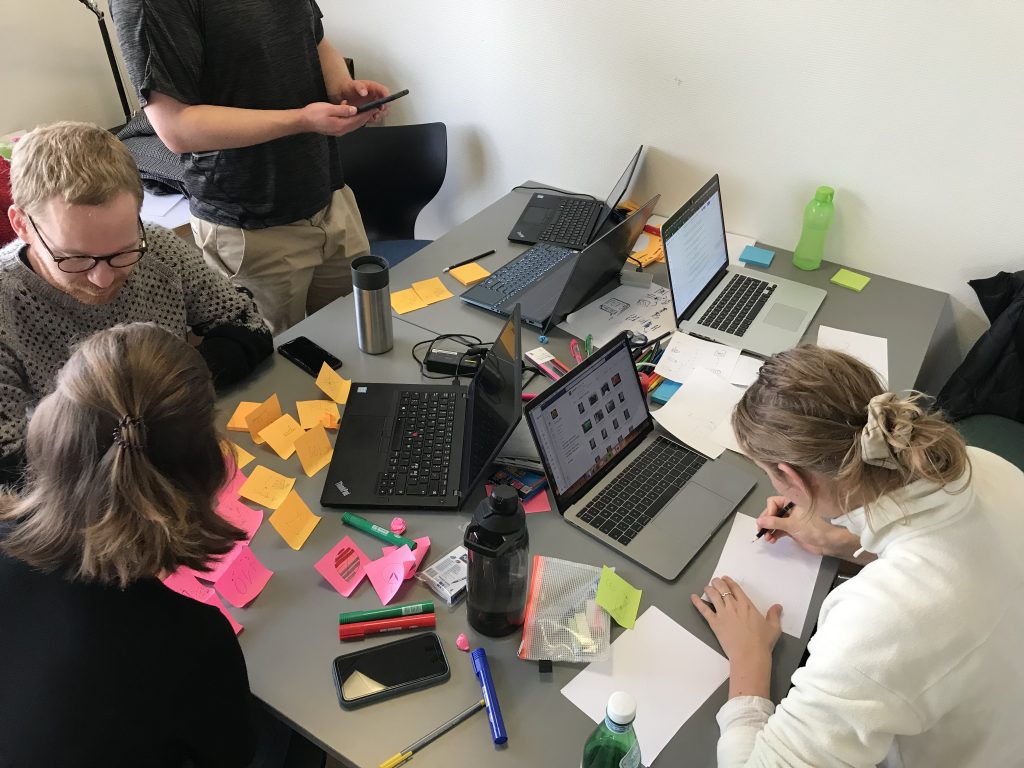
The first sketch
Green Scoreboard
This video shows how a green scoreboard, based on sensors and IoT, will motivate employees in a company to make more sustainable choices throughout the day at the office. With this concept we wanted to focus on the use of data to motivate and engage each employee in a company to be greener.
The video is made with stop motion.
The second sketch
Green Meeting
This video shows the concept of the Green Meeting feature in AskCodys Microsoft Integration. The “Green meeting” feature applies the most sustainable meeting possible based in intelligent data and IoT. The Green Meeting is enabled with the click of a button. We developed the Green Meeting function to help employees in a company to make sustainable decisions in a very easy way. With the Green Meeting we wanted to address both.
It is also this concept that we decided to redo and move on with, for using it as our final concept.
The video is made with images and a voice over to explain the narrative.
The third sketch
Reward for staying home
This video tackles dilemma of wanting to attend to meetings from home, but not the costs of missing the benefits at work for example free coffee and free gym etc.
The video is made with the Microsoft Powerpoint as a tool.
